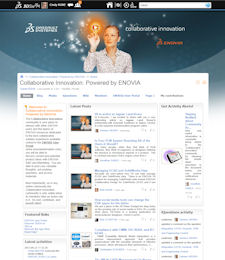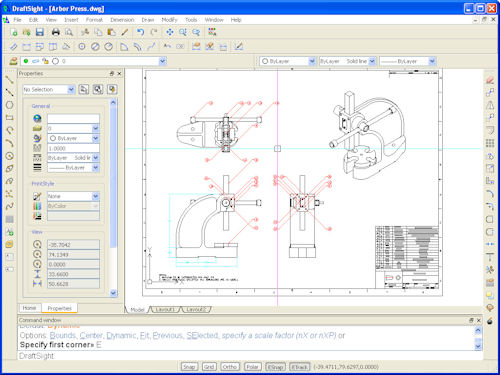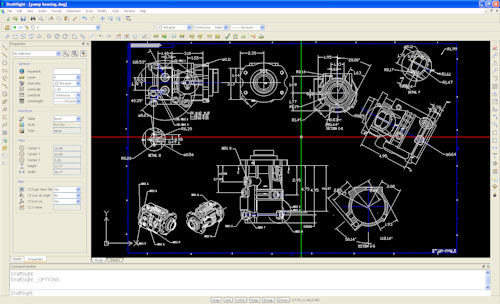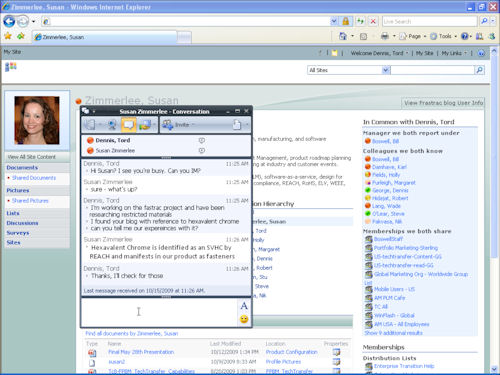Latest News
October 1, 2012
By Peter A. Bilello
Three powerful trends are converging in the digital enterprise: the “consumerization” of information technology (IT); the availability of massive amounts of information on mobile devices; and social media-savvy newcomers entering the workforce.
 |
| The ENOVIA Collaborative Innovation community is a place to interact and collaborate with ENOVIA users and members of teams with resources dedicated to the project. |
This convergence is forcing companies to implement new product lifecycle management (PLM)-related business processes and technologies that allow and enable social business collaboration. Ultimately, these trends will profoundly affect the ways we work, and even the way we live.
Collaboration will be changed forever, and much to the good. This upheaval has profound implications for PLM. At the heart of social business collaboration is an explosion “the nearly universal adoption of social media by those who recently started their careers. These workers are often referred to as the “millennials” or Generation Y “roughly speaking, those born since 1983. Gen-Y, now hiring in or achieving their first promotions, view the world around themselves differently from their predecessors. For Gen-Y, “work” is an impatient blend of information gathering and bottom-up decision-making. All their lives, they have dwelled in a digital world that is always on, always connected. They demand to be able to work “to connect “from anywhere, anytime.Right before our eyes, social business collaboration is revolutionizing the digital notion of top-down management of information, which until now has stood the test of time. Here’s a quick look at why this is changing:- Top-down “For decades, the accepted structure, hierarchy and architecture of information have been top-down. Tech-savvy Gen-Ys are frustrated by top-down, and sometimes rigid, information structures. These structures are a legacy of the post-World War II Baby Boom generation, which accounts for most of today’s senior managers.
- Management “The management of information is no longer the exclusive prerogative of IT departments. In parts of some enterprises, the accustomed authority over information flows, contents and formats is already slipping away. Because of the overwhelming impact of social media, day-to-day control is migrating to those who understand it best.
- Information “Big Data and the so-called data tsunami have been exhaustively analyzed. Information volumes grow at never-before-seen rates. Volumes double every few years, and even the best analyses are hard pressed to keep up. That is one reason why there are so few meaningful numbers about Big Data.
Information challenges also include variety, velocity and variability. New formats seem to appear daily. Gigabit speeds require faster, more powerful processors. Growing bandwidth means more online content, especially video and computer simulations.
As for variability, in the digital world, nothing has ever stayed the same for long. The once-ubiquitous MS-DOS and floppy drives are long gone, and CDs are becoming scarce. Paul Ottellini, president and CEO of silicon powerhouse Intel Corp., Santa Clara, CA, regards devices like personal computers as “form factors,” a milepost on the move “from the era of the personal computer to the era of personal computing.”It often goes unremarked that volume, variety, velocity and variability reinforce one another, which makes it easy to underestimate the looming impact of social business collaboration. The word “dynamic” cannot begin to describe what is happening, as social media collaboration becomes the new baseline of PLM. |
| Mechanical assembly drawing of an arbor press in Dassault Systemes DraftSight. |
Putting New Technologies to Work
Social business collaboration puts these technologies to work for the millennials now “and soon for the rest of us. This is most apparent in the consumerization of IT, which is the nearly universal availability of information on wireless mobile devices such as tablets and smartphones. These devices and the skill with which today’s workforce newcomers wield them are changing the ways workers collaborate “profoundly and in ways that are not yet predictable.The importance of wireless and mobile are hard to overstate. According to Juniper Research in Basingstoke, England, “the current total of 150 million employee-owned devices now being deployed in enterprises will balloon to 350 million by 2014. And that’s not even counting the hybrid tablet/smartphone devices that are on the horizon.”This is Bring Your Own Device (BYOD): BlackBerrys, iPhones, various Android devices and iPads connect to Facebook, YouTube, Twitter, Salesforce, etc., as well as an increasing number of everyday product development and associated supporting applications.In manufacturing enterprises, the convergence of these three trends is already obvious. Ramifications are being felt by users and PLM solution providers, from the biggest Fortune 500 corporations all the way down the size scale to mom-and-pop businesses.IT departments are affected in countless ways. Long-standing relationships among IT, product-development and lifecycle management “as well as the ways they share information “are dramatically changing, thanks to the emergence of social business collaboration. Social business collaboration is becoming the cartilage and central nervous system of the extended enterprise. This is because PLM, and the data and processes enabled within those solutions, touch every part of the extended enterprise. “The uncomfortable reality for IT and business executives,” wrote industry analyst Galen Gruman in a January article for InfoWorld.com, “is that most are operating in a fool’s paradise when it comes to the ]IT] consumerization trend.” |
| Mechanical detail drawing of a pump housing in DraftSight, which has an online collaboration community. |
Getting Down to Business
Established PLM solution providers “systems integrators, consultants, software developers and others “are catching on, and quickly catching up. Examples include Teamcenter Community from Siemens PLM Software; StreamWork and CubeTree from SAP for “ideation,” collaboration and community management; Windchill SocialLink from PTC; Oracle’s Agile PLM links to YouTube Channels; and ENOVIA SwYm (“See what You mean”) and the DraftSight community, both from Dassault Syst mes.Some or most of their connectivity comes from Microsoft SharePoint, IBM’s Lotus Quickr, Microsoft Office, Novell’s GroupWise, Facebook Business Pages, LinkedIn, WebEx, GoToMeeting, and YouTube. Google’ Drive is another good examples of simple social collaboration enablers.Newcomers to PLM are offering tools such as online business-application suites that enable social business collaboration’s flexibility, transparency and interactivity. This group includes newcomers such as Nuage, with its Caf © platform for document management within social business media environments; the Vuuch collaborative product development network that connects company communities, project teams and industry forums; and others such as Atlassian, Box, Huddle, Mzinga, Quirky, Telligent and Tasktop.All of these software developers offer mobile, online/cloud-based social media interaction with add-on capabilities for real-time collaboration. All of this enhances PLM as a strategic business approach.PLM itself is a consistent set of business solutions in support of the collaborative creation, management, dissemination, and use of product definition information across the extended enterprise. It spans from product concept to end-of-life (EOL) “integrating people, processes, business systems and information. PLM forms the product information backbone for a company and its extended enterprise.Whether bolt-on or third-party, this myriad of PLM enhancements includes analytics, smoother integration among users of dissimilar applications, file sharing, video conferencing and online meetings. Also emerging are tracking and management of cumbersome tasks such as requirements, open issues, documents, configurations and workflows. All of this is rapidly evolving.Traditionally, these tasks have been managed with e-mail; interoperability among CAD systems such as IGES and STEP; FTP; and, of course, the telephone. But compared with social media collaboration, these older technologies are costly and complex.PLM solution providers have common goals in social business collaboration. They want to give PLM users the same extraordinary experience that product developers strive to give their customers. Specific PLM capabilities aside, all three groups are striving to see that PLM makes the development of new products straightforward, more intuitive, and eventually more transparent. Ultimately, engineers, technicians and managers will spend less time searching for information, for support, on managing information, and more time on the projects and decisions for which they are paid. Regardless of strategy specifics, user interface looks-and-feels, and functionality details, PLM is rapidly gaining new capabilities. These include:- Rapid identification of individuals who can help with specific tasks.
- Support for the free flow of ideas in an open environment.
- Always available, always on, always connected, anywhere, and at any time, on individual personal mobile devices.
- Intuitive, natural and personal forms “flexible, ad hoc “that empower Gen-Y.
- Balancing data access and corporate security without interfering with any of the above.
The benefits of such an approach in the PLM context are significant. Everyone in the organization, not just Gen-Y new hires, will be better connected to the individuals and data that they need “when they need it, in the form needed. This type of connectivity was long ago proven to speed decision-making, improve the processes, enhance product quality, shorten time to market, and increase organizational efficiencies.
 |
| Teamcenter for community collaboration leverages familiar capabilities from Microsoft Office such as Presence, Instant Messaging and My Site (Sharepoint) to make corporate social networking personal, timely and productive. |
Connecting the Dots
Social business collaboration goes far beyond overhauling user interfaces. For PLM solution providers as well as for their customers, the essentials include dedicated investments in facilities, equipment, processes and people; systematic, purpose-driven efforts by everyone in the extended enterprise to share knowledge; and building relationships of trust everywhere. This becomes, then, a very big job. Collaboration in new-product design has always included choosing materials, analyzing designs, locating resources and allocating them, gearing up supply chains, developing and simulating myriad production systems, and establishing launch schedules. Add to that the drawing up of bills of materials (BOMs), determining warranty coverage/out-of-warranty service, refining the logistics in-bound supply chains and out-bound distribution networks, supporting sales teams, keeping business partners in sync, ensuring that marketing is effective, and protecting the intellectual property/assets, with sometimes hundreds of patent applications. With the widespread use of “intelligent” electro-mechanical devices (mechatronics), new-product engineering also includes the coding of embedded software, writing control algorithms and debugging them. That has meant inserting new decision points and “phase gates” into traditional product-development processes. Moreover, product development encompasses regulatory approvals, ongoing compliance verification, and the EOL challenges “ecologically sustainable recycling and environmentally safe disposal of anything that remains. The point of this recitation is to make clear how many steps and processes are involved. Simply stating “all of them” makes it too easy to gloss over the challenges, and miss the opportunities. This is also why truly connecting the dots is nearly impossible, except for very short periods of time, with informational snapshots that quickly outdate.Social media collaboration is here to stay, despite the potential for information overloads. Without it, many new products would never reach today’s global marketplace. The power, so to speak, of social business collaboration is that it can help generate better products in less time, get those products to markets and showrooms at lower cost, and manage them better throughout their lifecycles. Good solutions are emerging, and even better ones are in development. Ultimately, social business collaboration will become part of the users’ lives on and off the job. Meanwhile, new-product development is being recapitalized intellectually, and this new leverage is already transforming PLM. Laggard adopters will struggle to keep up, and some may find themselves leveraged out of the marketplace entirely.Peter Bilello is president of CIMdata. Send e-mail about this article to [email protected].
More Info
Atlassian Box CIM Data Dassault Systemes Facebook Google GoToMeeting Huddle IBM Intel Corp. LinkedIn Microsoft Mzinga Novell Nuage Oracle PTC Quirky Salesforce SAP Siemens PLM Software Tasktop Telligent Vuuch WebExSubscribe to our FREE magazine, FREE email newsletters or both!
Latest News
About the Author
DE’s editors contribute news and new product announcements to Digital Engineering.
Press releases may be sent to them via [email protected].






